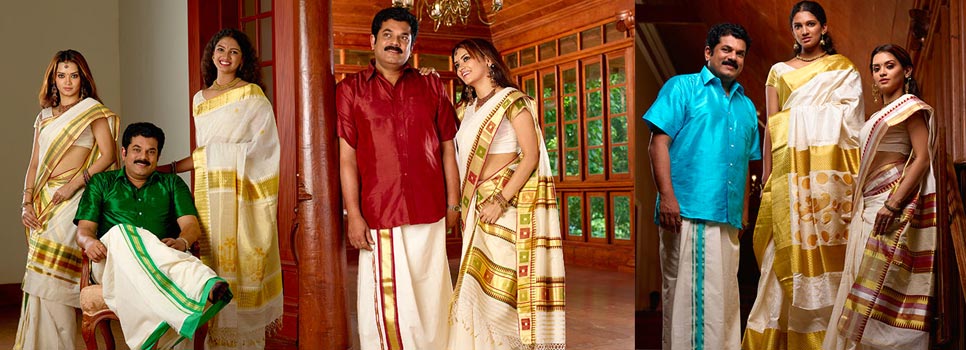Traditional Costumes Worn by the People of Kerala
Updated:- [12/Sep/23] Kerala's traditional costumes are a reflection of the state's rich cultural heritage. Kerala's traditional costumes are known for their vibrant colors, intricate designs, and unique patterns. If you're planning a visit to Kerala, you can conduct a kerala Tour Package Booking to experience the state's rich culture and traditions. Kerala's traditional costumes are one of the many attractions that you can explore during your visit. From the vibrant colors to the intricate designs, Kerala's traditional costumes are sure to leave you mesmerized. The dresses worn by Keralites are totally based on their religion. The fabric of the clothes is usually cotton, as they are quite comfortable during the hot and humid season.

Traditional dresses for men
1. Mundu: Alleppey is synonymous with its mesmerizing backwaters. The interconnected network of canals, lakes, and lagoons offers visitors a chance to unwind on traditional houseboats, gently drifting along the serene waters lined with swaying palms and lush greenery. The tranquil backwaters provide a soothing escape from the hustle and bustle of modern life, offering an opportunity for introspection and relaxation.
2. Melmundu: It is another part of white-coloured cloth used for covering the upper part of the body of men. The style of wearing the Melmundu is draping over the shoulders. Presently, men prefer to wear shirts rather than Melmundu.
3. Jubba: Jubba is also an upper garment meant for men. It is usually paired with Mundu. Jubba is again made of cotton and silk, and the pairing of Mundu and Jubba is common during any traditional festivals or occasions.
Men’s attire according to their religious communities
1. Hindus: Men from the Hindu community wear Mundu with a shirt or Melmundu, while Brahmins add Uthareeyam for a more traditional look.
2. Muslims: Christian men prefer western attire such as shirts and trousers or full suits with blazers, but some may wear a plain shirt with Mundu.
3. Christians: In addition to the traditional Kerala dress of Mundu and Melmundu or shirts, Muslim men also wear Kurtas and Sherwanis on special occasions.
Traditional dresses for women
1. Mundum Neriyathum: Women in Kerala wear a saree or a three-piece set called Mundum Neriyathum. One piece of cloth is called a Mundu. The clothes are usually made of cotton or silk and are available mostly in off-white and white colours. The three clothes are worn together to give a resembling look of a saree. The mundu is wrapped around the waist like a lungi, but the front is pleated like that of a saree. The jubba-like cloth is wrapped around the upper part of the body like a blouse and the third cloth named Neriyathum is tucked on in the lower Mundu and the other end is worn over the shoulder like a saree’s pallu.
2. Silk Sarees: Kerala women primarily choose to wear silk sarees on traditional occasions as they are lightweight and embellished with beautiful embroidery and designs. Sarees are also a common attire of the brides, especially the Hindu brides.
Bridal attire of different communities
1. Hindu brides: Hindu brides in Kerala wear Kanchipuram sarees in vibrant colors with rich borders, paired with gold ornaments, heavy makeup, and flowers.
2. Muslim brides: Muslim brides usually wear heavily embroidered silk sarees with gorgeous borders and a well-crafted dupatta worn over the head.
3. Christian brides: Like other parts of the country and the world, Christian brides wear white gowns with minimal ornamentation.
Kerala's traditional costumes are incomplete without the Kasavu or Thorthu, which is a shawl worn by both men and women. The Kasavu or Thorthu is made of cotton and is characterized by a thick gold border, which adds to its elegance and beauty.
Kerala Tour Packages:
- Amazing Kerala Budget Tour
- Best Magical Kerala Tour
- Exotic Kerala Tour
- Offbeat Kerala Family Package
- Kerala Hills Backwater Beaches
- Through the Hills and Backwaters
- Beaches and Backwaters of Kerala
- Enchanting Hill Stations Tour
- Relaxing Beach Vacation
- Beach Excursion of Kerala
- Kerala Tamilnadu Tour
- Tamilnadu tour with kerala
- Kerala and tamilnadu package
- Karnataka and Tamil Nadu